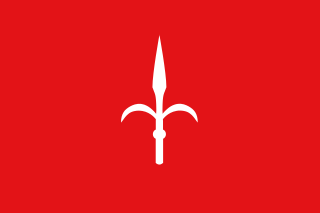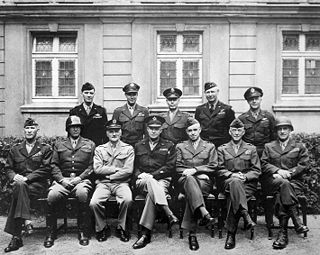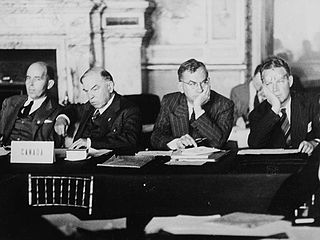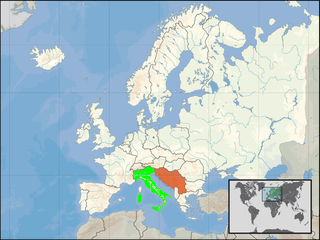
Trieste is a city and seaport in northeastern Italy. It is the capital and largest city of the autonomous region of Friuli-Venezia Giulia, as well as of the regional decentralization entity of Trieste.

The Free Territory of Trieste was an independent territory in Southern Europe between northern Italy and Yugoslavia, facing the north part of the Adriatic Sea, under direct responsibility of the United Nations Security Council in the aftermath of World War II. For a period of seven years, it acted as a free city.

Free France was a political entity that claimed to be the legitimate government of France following the dissolution of the Third Republic. Led by General Charles de Gaulle, Free France was established as a government-in-exile in London in June 1940 after the Fall of France during World War II and fought the Axis as an Allied nation with its Free French Forces. Free France also supported the resistance in Nazi-occupied France, known as the French Forces of the Interior, as well as gained strategic footholds in several French colonies in Africa.

The European Theater of Operations, United States Army (ETOUSA) was a theater of Operations responsible for directing United States Army operations throughout the European theatre of World War II, from 1942 to 1945. It commanded Army Ground Forces (AGF), United States Army Air Forces (USAAF), and Army Service Forces (ASF) operations north of Italy and the Mediterranean coast. It was bordered to the south by the North African Theater of Operations, United States Army (NATOUSA), which later became the Mediterranean Theater of Operations, United States Army (MTOUSA).

The Paris Peace Treaties were signed on 10 February 1947 following the end of World War II in 1945. The Paris Peace Conference lasted from 29 July until 15 October 1946. The victorious wartime Allied powers negotiated the details of peace treaties with those former Axis powers, namely Italy, Romania, Hungary, Bulgaria, and Finland, which had switched sides and declared war on Germany during the war. They were allowed to fully resume their responsibilities as sovereign states in international affairs and to qualify for membership in the United Nations. Nevertheless, the Paris Peace Treaties avoided taking into consideration the consequences of the Molotov–Ribbentrop Pact, officially known as the Treaty of Non-Aggression between Germany and the Union of Soviet Socialist Republics, whose secret clauses included the division of Poland between Nazi Germany and the Soviet Union, the occupation of the Baltic States, and the annexation of parts of Finland and Romania. The Molotov–Ribbentrop Pact changed the borders agreed after the Paris Peace Conference (1919–1920), and was signed on August 23, 1939. One week later, World War II started with Nazi Germany’s invasion of Poland, followed three weeks later by the Soviet invasion of Poland, which was completely erased from the map. In the following years, Nazi Germany and the Soviet Union changed the borders established by the peace treaties at the end of World War I.

This is an introduction to the postal and philatelic history of Italy.

The Allies, formally referred to as the United Nations from 1942, were an international military coalition formed during World War II (1939–1945) to oppose the Axis powers, led by Nazi Germany, the Empire of Japan, and the Kingdom of Italy. Its principal members by the end of 1941 were the "Big Four" - United Kingdom, United States, Soviet Union, and China.

The entirety of Germany was occupied and administered by the Allies of World War II from the Berlin Declaration on 5 June 1945 to the establishment of West Germany on 23 May 1949. Unlike occupied Japan, Germany was stripped of its sovereignty and former state: after Nazi Germany surrendered on 8 May 1945, four countries representing the Allies asserted joint authority and sovereignty through the Allied Control Council (ACC) under the Berlin Declaration of 5 June 1945 that led to the fall of the German Reich. At first, Allied-occupied Germany was defined as all territories of Germany before the 1938 Nazi annexation of Austria; the Potsdam Agreement on 2 August 1945 defined the new eastern German border by giving Poland and the Soviet Union all regions of Germany east of the Oder–Neisse line and divided the remaining "Germany as a whole" into four occupation zones, each administered by one of the Allies.
Venezia Giulia Police Force was a police corps formed after World War II by the Allied Military Government in Zone A of Venezia Giulia. Operating in the Free Territory of Trieste after 1947, it was active until 1961. From 1945 to 1954 it was directed by Col. Gerald Richardson, a former Scotland Yard officer.

The Morgan Line was the line of demarcation set up after World War II in the region known as Julian March which prior to the war belonged to the Kingdom of Italy. The Morgan Line was the border between two military administrations in the region: the Yugoslav on the east, and that of the Allied Military Government on the west. After 15 September 1947, the Allied Military Government was composed of both the British Element Trieste Forces (BETFOR) troops from the United Kingdom and the Trieste United States Troops (TRUST) from the United States.

Major-General Francis James Rennell Rodd, 2nd Baron Rennell, known as Lord Rennell, was an army officer and the second but eldest surviving son of the diplomat Rennell Rodd, 1st Baron Rennell. He served as a Chief of Civil Affairs in the Mediterranean theatre of war from 1941 to 1944.

The story of the postage stamps and postal history of Yugoslavia officially begins with the formation of the Kingdom of Serbs, Croats and Slovenes on 1 December 1918.
The French State, popularly known as Vichy France, as led by Marshal Philippe Pétain after the Fall of France in 1940 before Nazi Germany, was quickly recognized by the Allies, as well as by the Soviet Union, until 30 June 1941 and Operation Barbarossa. However, France broke with the United Kingdom after the destruction of the French Fleet at Mers-el-Kebir. Canada maintained diplomatic relations until the occupation of Southern France by Germany and Italy in November 1942.

Italy–Yugoslavia relations are the cultural and political relations between Italy and Yugoslavia in the 20th century, since the creation of Yugoslavia in 1918 until its dissolution in 1992. Relations during the interwar years were hostile because of Italian irredentist demands to Yugoslav territory, leading to Fascist Italy and the Axis Powers invading Yugoslavia during World War II. After lingering tensions after the war over the status of the Free Territory of Trieste, relations improved during the Cold War.

The Army command Trieste United States Troops (TRUST) was established 1 May 1947 in accord with a protocol to the Treaty of Peace with Italy which created the Free Territory of Trieste as a new independent, sovereign State under a provisional regime of Government and under the direct responsibility of the United Nations Security Council.

This is a survey of the postage stamps and postal history of Slovenia.
Municipal elections were held in the six municipalities of the Anglo-American occupation zone of the Free Territory of Trieste in June 1949, Trieste, Duino-Aurisina, San Dorligo della Valle, Sgonico, Monrupino and Muggia. There were 197,266 eligible voters in the electoral rolls in Trieste and a combined number of 15,392 eligible voters in the five other municipalities.
France was one of the largest military powers to come under occupation as part of the Western Front in World War II. The Western Front was a military theatre of World War II encompassing Denmark, Norway, Luxembourg, Belgium, the Netherlands, the United Kingdom, France, Italy, and Germany. The Western Front was marked by two phases of large-scale combat operations.
Kingdom of the South is the definition used in Italian historiography regarding the part of southern Italy controlled by the Allied Military Government of Occupied Territories (AMGOT) and ruled by AMGOT in cooperation with governments of the Kingdom of Italy, as opposed to German-occupied northern and central Italy, where the Italian Social Republic had been established. The term refers to the period between September 1943, when King Victor Emmanuel III and the government fled Rome to Brindisi in the aftermath of the armistice of Cassibile, and June 1944, when Rome was liberated by the Allies and resumed its function as capital of Italy. Regno del Sud was not an official designation; all documents and acts referred to it as the Kingdom of Italy.

















